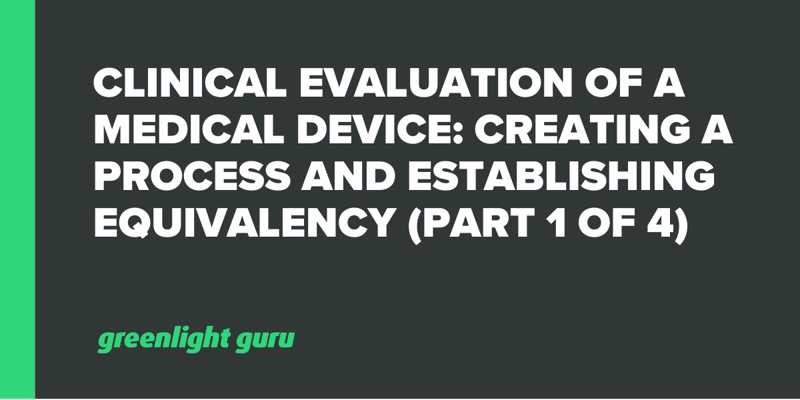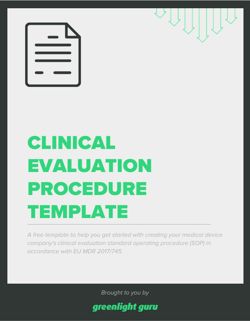Clinical Evaluation of a Medical Device: Creating a Process and Establishing Equivalency (Part 1 of 4)

To obtain a CE marking and market your medical device in the EU, you’ll first need to perform a clinical evaluation—and report your findings in a Clinical Evaluation Report (CER).
A clinical evaluation is required for every medical device sold in the EU, regardless of risk classification, and it tends to be a lengthy and highly involved process.
At Greenlight Guru, we understand just how difficult the process of collecting and analyzing clinical data can be, which is why we’ve put together a series of articles on the essentials of clinical evaluation for medical devices.
This is the first of four articles in this series, and in it, I’ll detail how you can define the scope of your clinical evaluation, create a plan, and establish equivalency for your device.
WHAT TO EXPECT IN THIS 4-PART SERIES |
| Part 1: Clinical Evaluation of a Medical Device: Creating a Process and Establishing Equivalency (this article) |
|
Part 2: The Clinical Evaluation Literature Review Process: Identifying and Appraising Clinical Data |
|
Part 3: Performing Data Analysis for Your Medical Device’s Clinical Evaluation |
|
Part 4: How to Create a Clinical Evaluation Report (CER) under MEDDEV & MDR |
Steps in the medical device clinical evaluation process
Clinical evaluation of medical devices is mandated under the EU Medical Device Regulation (EU MDR). However, the clinical evaluation process is laid out in MEDDEV 2.7.1 Rev 4, a guidance document put out by the European Commission.
MEDDEV 2.7.1 Rev. 4 lists four stages of a clinical evaluation:
-
Stage 0 - Scope: The scope and context of the clinical evaluation, including the product being tested and any sizes or settings covered in the evaluation. This also includes an explanation of the technology the device is based on and any claims about its performance or safety.
-
Stage 1 - Identification of pertinent data: This may include any data generated by the manufacturer, including premarket clinical investigations, as well as data from literature.
-
Stage 2 - Appraisal of data: In this stage the data is appraised and the validity of each data set must be determined, as well as its relevance to the clinical evaluation and how heavily it should be weighed in the overall evaluation.
-
Stage 3 - Analysis of clinical data: This is the actual analysis of the clinical data, which should include the benefits and risks of the device, explain the acceptability of the benefit/risk profile, and address any residual risks, uncertainties, or unanswered questions.
Additionally, there is a fifth stage (stage 4) that the guidance document places in its own category: writing the CER. The CER is a living document which demonstrates that your device fulfills its intended purpose without compromising the safety of patients or users.
Your CER is only as good as the clinical data you obtain and your methods for analyzing it, so let’s take a closer look at the first stage of your clinical evaluation.
Define your scope and build a clinical evaluation plan
Clinical evaluation is a systematic process. In practice, this means you need to create a plan for carrying out the evaluation and then document the steps you took in executing that plan.
MEDDEV 2.7.1 Rev 4 states that your first step should be to define the scope of the evaluation, which should include:
-
The device description.
-
Any design features, indications, or target populations that need specific attention during the evaluation.
-
The information you need for evaluating equivalence, if you intend to claim it.
-
Risk management documents such as the hazard identification list and any clinical risks identified from the risk analysis. Your clinical evaluation will be expected to address the significance of any clinical risks that exist after risk mitigation strategies have been applied during design.
-
Current knowledge or state of the art. This includes other devices and medical alternatives available to the target population and information about the condition managed by the device and its natural course. This also includes applicable standards and guidance documents.
-
The data sources and types you will use in the clinical evaluation. This may be data generated by the manufacturer (direct) or data from scientific literature (indirect).
Once you’ve addressed the scope of your clinical evaluation, you need to put together the plan that will guide your data collection, appraisal, and analysis.
You can find the requirements for a clinical evaluation plan in Annex XIV of MDR, which states that the plan should at least include:
-
The general safety and performance requirements that you need to support with relevant clinical data.
-
The intended purpose of your device.
-
The intended target populations with clear indications and contra-indications.
-
The intended clinical benefits to patients with relevant and specified clinical outcome parameters.
-
The methods you’ll use for examining qualitative and quantitative aspects of clinical safety with clear reference to the determination of residual risks and side-effects.
-
The parameters you’ll use to determine, based on the state of the art in medicine, the acceptability of the benefit-risk ratio for the various indications and for the intended purpose(s) of the device.
-
How you will address benefit-risk issues relating to specific components such as use of pharmaceutical, nonviable animal, or human tissues.
-
A clinical development plan indicating progression from exploratory investigations, such as first-in-man studies, feasibility and pilot studies, to confirmatory investigations, such as pivotal clinical investigations, and a post-market clinical follow-up (PMCF) with an indication of milestones and a description of potential acceptance criteria.
Establish equivalency with devices already on the market
Though it isn’t listed as one of the discrete stages in clinical evaluation, if you intend to establish equivalency with another device, you should do so before gathering clinical data.
That’s because if you can establish equivalence with another device, you can use literature and clinical data regarding the equivalent device in your clinical evaluation. It also saves you from potentially having to perform a redundant clinical investigation when there are already studies available on an equivalent device.
Keep in mind, under EU MDR, you must demonstrate that your device is equivalent in all three of the following ways:
-
Clinical
-
Technical
-
Biological
The full criteria for these characteristics is laid out in Annex I of MEDDEV 2.7.1 Rev 4. However, there are differences between the text in EU MDR and MEDDEV, which the European Commission has addressed in their guidance document on equivalence, MDCG 2020-5.
Up next: identifying relevant data and creating a literature review protocol
Now that you’ve established the scope for your clinical evaluation, created a plan to carry it out, and identified any equivalent devices, your next step is to begin gathering relevant data. Check out the next post of this 4-part blog series for an in-depth look at identifying and appraising clinical data for your device.
Looking for an all-in-one QMS solution to advance the success of your in-market devices and integrates your post-market activities with product development efforts? Click here to take a quick tour of Greenlight Guru's Medical Device QMS software →
Niki Price is a Medical Device Guru who has spent her entire career working with different types of medical devices. She began her journey in production, which is where she discovered how important and fulfilling this line of work was to her! Spending time in both Quality and R&D, she enjoys the product development...
Related Posts
Ultimate Guide to Clinical Evaluation of a Medical Device in the EU
How to Create a Clinical Evaluation Report (CER) under MEDDEV & MDR (Part 4 of 4)
Performing Data Analysis for Your Medical Device’s Clinical Evaluation (Part 3 of 4)
Get your free template
Clinical Evaluation Procedure Template


%20The%20Ultimate%20Guide%20to%20Clinical%20Evaluation%20of%20a%20Medical%20Device-1.png?width=180&name=(cover)%20The%20Ultimate%20Guide%20to%20Clinical%20Evaluation%20of%20a%20Medical%20Device-1.png)








